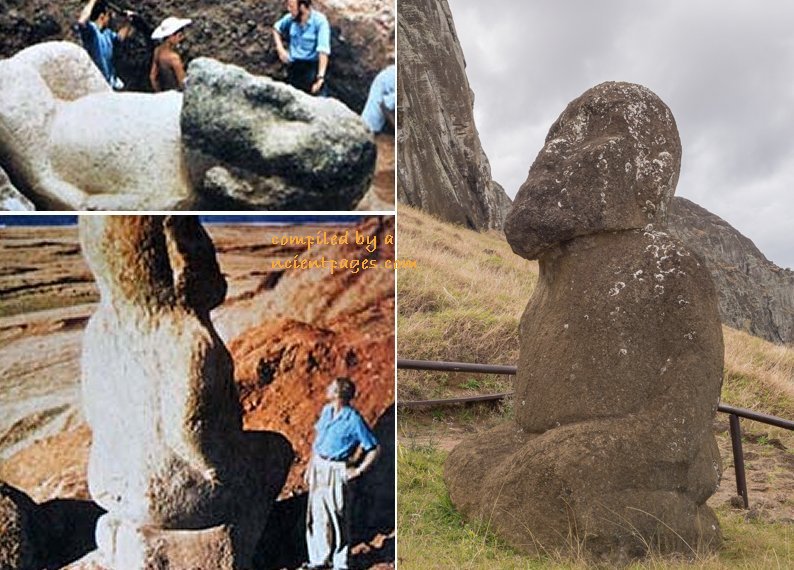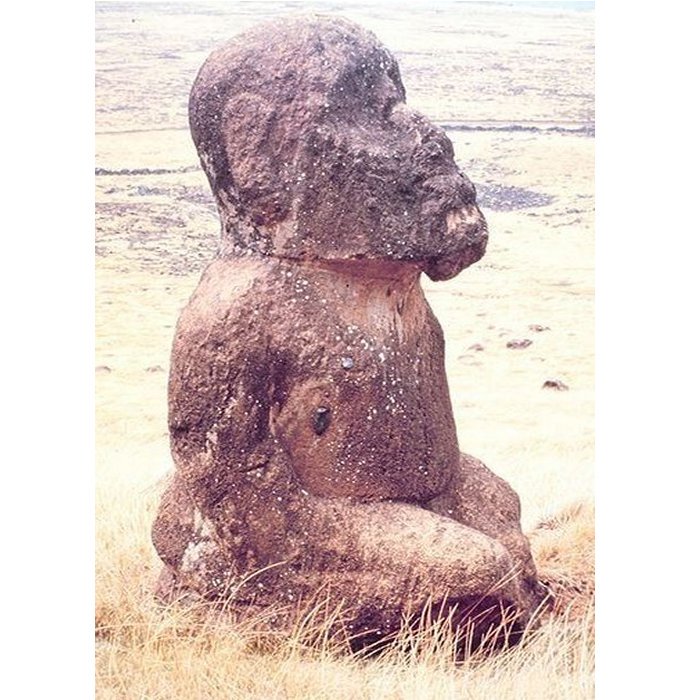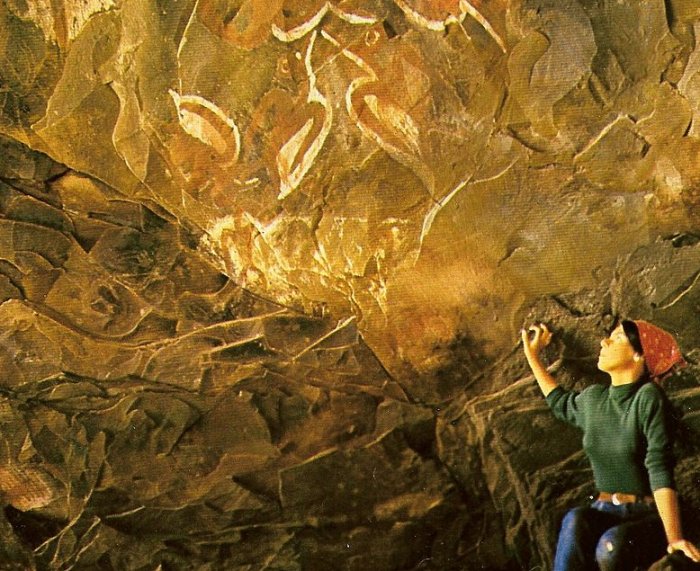Unusual Tukuturi Statue On Easter Island Remains An Unexplained Mystery
A. Sutherland - AncientPages.com - Easter Island keeps many ancient secrets.
One of them is an intriguing "kneeling moai or simply "Tukuturi" figure that was discovered on Easter Island by archaeologist Thor Heyerdahl's team in 1955.
The place of this most unusual discovery was the Rano Raraku quarry. Curiously, no other statues accompany this statue, which remains an unusual moai.
The statue's kneeling position catches our attention. Is the kneeling position a way to show admiration and respect toward his gods or is he perhaps, begging for mercy or forgiveness?
The statue of “Tukuturi” is also known as ‘tuku turi or simply ‘tuku’; it differs much from many other moai on Easter Island.
Why is the figure's location away from other sculptures? This figure differs much from other traditional statues on the island.
Unlike the other stone colossi, Tukuturi's facial characteristics are rounded, much more human-like when compared to the traditional, straight rectangular heads of the other moai.
If you look from the side, you could even see that this being has a small beard. But that's not all. The figure has also well-defined legs and it is kneeling with its hands resting on the knees.
Was Tukuturi A Famous Figure Or Just A Chorus Singer?
One legend says that this is a depiction of a famous moai sculpture erected to watch over future generations of the island's craftsmen.
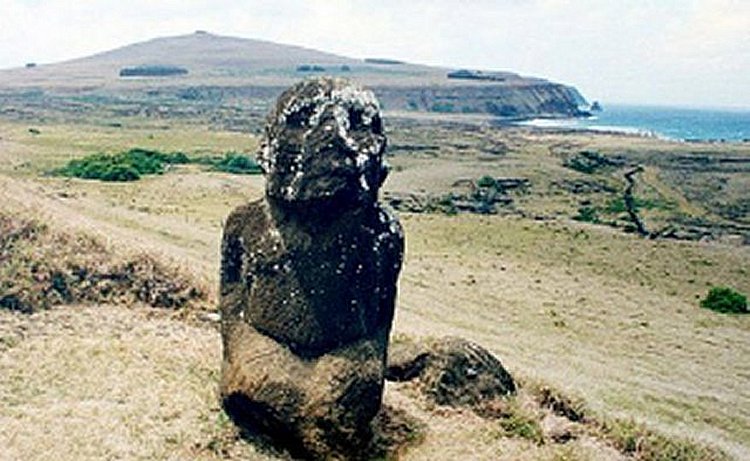 The only kneeling Moai at Easter Island. Photographed by Brocken Inaglory in November of 1998. Image credit: Brocken Inaglory - CC BY-SA 3.0
The only kneeling Moai at Easter Island. Photographed by Brocken Inaglory in November of 1998. Image credit: Brocken Inaglory - CC BY-SA 3.0
According to an ancient tradition, the posture of the mysterious “Tukuturi” was used by the men and women who formed the chorus in the festivals called riu, where the posture was known as’ tuku riu’.
Typical also of the singers was the slightly backward inclination of the trunk, the raised head, and the goatee (a style of facial hair incorporating hair on a man's chin but not his cheeks), all these features can be observed in this statue.
Tukuturi is made of red scoria from Puna Pau located on the outskirts of Hanga Roa in the south west of Easter Island. Puna Pau is the only source of red scoria that was used to carve the pukao (topknots) that they put on the heads of some of their famous moai figures.
However, Tukuturi sits at Rano Raraku, the tuff quarry and it is believed this statue is probably one of the last moai ever made.
Were Traditional Moai Created Before Tukuturi Or Was He, Their Predecessor?
It is not easy to answer this question and no one knows for sure but some researchers argue that Tukuturi may belong to a later period.
Tukuturi moai. Image credit: Crux - Public Domain
Still, the most common idea is that it was one of the first sculptures to be made - an early precursor of the traditional moai. However, it wasn't transported but left in the quarry because it was either damaged or never intended to be erected on a platform.
Perhaps we have to ask whether the mysterious kneeling Tukuturi really is "moai" figure, in the first place.
The statue's kneeling position catches our attention. Is the kneeling position a way to show admiration and respect toward his gods or is he perhaps, begging for mercy or forgiveness?
Is this the position of someone who will be sacrificed?
Among many theories, there is one suggesting that Tukuturi moai is connected to the Tangata manu cult of Easter Island, a traditional competition on Rapa Nui, which would make Tukuturi one of the last moai on the island to have been created.
Tukuturi remains an unsolved mystery because there are no satisfactory answers to some crucial questions regarding this curious figure.
Why is the figure's location away from other sculptures?
Why is Tukuturi kneeling? Why wasn’t the statue created out of the same material like other statues on the Easter Island?
Birdmen (Tangata manu) paintings in the so-called "Cannibal Cave". Storia Illustrata, year 1969. source
Father Sebastian Englert (1888 – 1969), a Capuchin Franciscan friar, Roman Catholic priest, missionary, linguist and ethnologist from Germany. He is known for his pioneering work on Easter Island.
He said that "masters who had built the beautiful Inca walls of the first period, were not also the creator of the mighty half figures who has made Easter Island so famous.
They created a series of simpler statues [like Tukuturi] with a rounded head and staring eyes, sometimes red tuff and sometimes of black basalt, but also already used the yellow-gray volcanic rock, which was so popular in the next period..." ("Aku-.Aku, T. Heyerdahl).
Written by – A. Sutherland - AncientPages.com Senior Staff Writer
Copyright © AncientPages.com All rights reserved. This material may not be published, broadcast, rewritten or redistributed in whole or part without the express written permission of AncientPages.com
Expand for referencessource:
Aku-.Aku, T. Heyerdahl
More From Ancient Pages
-
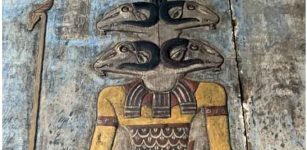 Reliefs And Engravings Of Celestial Bodies And A Zodiac On Walls And Ceilings Of Luxor’s Esna Temple
Archaeology | Oct 5, 2023
Reliefs And Engravings Of Celestial Bodies And A Zodiac On Walls And Ceilings Of Luxor’s Esna Temple
Archaeology | Oct 5, 2023 -
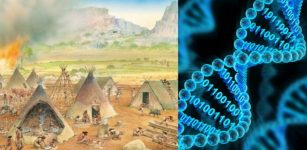 95% Of All Modern Europeans Descended From The Seven Daughters Of Eve
Civilizations | Dec 12, 2019
95% Of All Modern Europeans Descended From The Seven Daughters Of Eve
Civilizations | Dec 12, 2019 -
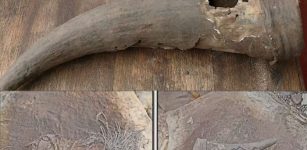 Unusual Parcel With 500-Year-Old Horn Container Discovered In South Africa Sheds Light On Pre-Colonial Khoisan Medicines
Featured Stories | Feb 15, 2023
Unusual Parcel With 500-Year-Old Horn Container Discovered In South Africa Sheds Light On Pre-Colonial Khoisan Medicines
Featured Stories | Feb 15, 2023 -
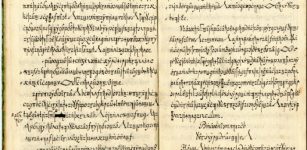 Copiale Cipher – Secrets Of Mysterious Coded Manuscript And The Oculist Order
Artifacts | Feb 4, 2019
Copiale Cipher – Secrets Of Mysterious Coded Manuscript And The Oculist Order
Artifacts | Feb 4, 2019 -
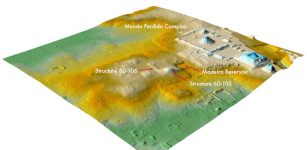 Hidden Ancient Citadel In The Mayan City Of Tikal Discovered By LIDAR
Archaeology | Sep 28, 2021
Hidden Ancient Citadel In The Mayan City Of Tikal Discovered By LIDAR
Archaeology | Sep 28, 2021 -
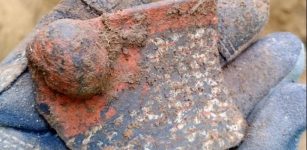 6,000-Year-Old Discovery Of Artifacts Associated With Ancient Lengyel Culture
Archaeology | Mar 27, 2020
6,000-Year-Old Discovery Of Artifacts Associated With Ancient Lengyel Culture
Archaeology | Mar 27, 2020 -
 Gravitational Waves Shed Light On The Mysterious Antikythera Mechanism
News | Jun 29, 2024
Gravitational Waves Shed Light On The Mysterious Antikythera Mechanism
News | Jun 29, 2024 -
 First AI-Based Method For Dating Archaeological Remains Developed By Researchers
Archaeology | Aug 23, 2022
First AI-Based Method For Dating Archaeological Remains Developed By Researchers
Archaeology | Aug 23, 2022 -
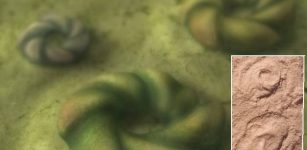 Earth’s First Animals Had Particular Taste In Real Estate
Evolution | May 10, 2023
Earth’s First Animals Had Particular Taste In Real Estate
Evolution | May 10, 2023 -
 On This Day In History: First Battle Of Reading Took Place – On Jan 4, 871 AD
News | Jan 4, 2017
On This Day In History: First Battle Of Reading Took Place – On Jan 4, 871 AD
News | Jan 4, 2017 -
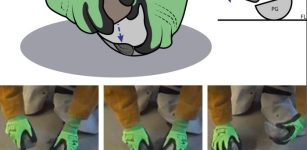 Can Early Stone Tools Offer Proof Our Ancestors Were Becoming Human, Both Mentally And Culturally?
Archaeology | Jul 7, 2022
Can Early Stone Tools Offer Proof Our Ancestors Were Becoming Human, Both Mentally And Culturally?
Archaeology | Jul 7, 2022 -
 Ancient Roman Altarpieces Deciphered And New Roman Goddess Uncovered In The Netherlands
Archaeology | Jun 18, 2024
Ancient Roman Altarpieces Deciphered And New Roman Goddess Uncovered In The Netherlands
Archaeology | Jun 18, 2024 -
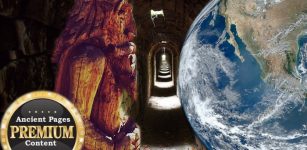 Mysterious Advanced Underground Civilization And A Secret Society – Dangerous Knowledge And Verdict – Part 3
Ancient Mysteries | Apr 24, 2018
Mysterious Advanced Underground Civilization And A Secret Society – Dangerous Knowledge And Verdict – Part 3
Ancient Mysteries | Apr 24, 2018 -
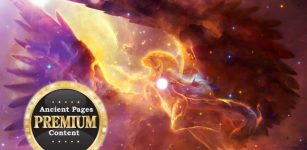 Knowledge Of Divine Alien Beings And High-Tech In Ancient Egypt Described In Sacred Books And Papyrus – Reincarnation, Cloaking Technology And Space Travel – Part 2
Ancient Mysteries | May 16, 2021
Knowledge Of Divine Alien Beings And High-Tech In Ancient Egypt Described In Sacred Books And Papyrus – Reincarnation, Cloaking Technology And Space Travel – Part 2
Ancient Mysteries | May 16, 2021 -
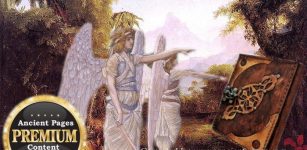 Precious Lost Ancient Book Of Wisdom Could Solve Biblical Mysteries
Ancient Mysteries | Nov 26, 2018
Precious Lost Ancient Book Of Wisdom Could Solve Biblical Mysteries
Ancient Mysteries | Nov 26, 2018 -
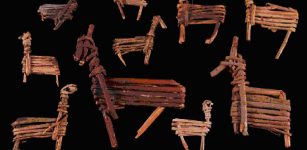 Tusayan Pueblo Ruins And Split Twig Figurines Tell Story Of People Who Once Inhabited The Grand Canyon
Civilizations | Nov 13, 2018
Tusayan Pueblo Ruins And Split Twig Figurines Tell Story Of People Who Once Inhabited The Grand Canyon
Civilizations | Nov 13, 2018 -
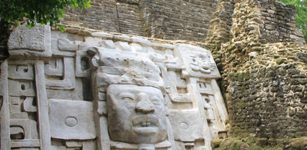 Lamanai, Belize: One Of The Largest And Oldest Maya Cities Dated To 1500 BC
Civilizations | Nov 2, 2018
Lamanai, Belize: One Of The Largest And Oldest Maya Cities Dated To 1500 BC
Civilizations | Nov 2, 2018 -
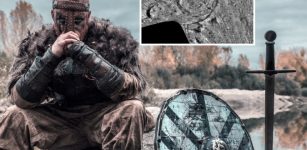 Something Never-Before-Seen Is Hidden Beneath 15 Giant Viking Burial Mounds Spotted By Radar In Norway
Archaeology | Jan 19, 2021
Something Never-Before-Seen Is Hidden Beneath 15 Giant Viking Burial Mounds Spotted By Radar In Norway
Archaeology | Jan 19, 2021 -
 8th Century Sculpture Of Lord Vishnu Belonging To Pandya Dynasty – Unearthed
Archaeology | Sep 16, 2020
8th Century Sculpture Of Lord Vishnu Belonging To Pandya Dynasty – Unearthed
Archaeology | Sep 16, 2020 -
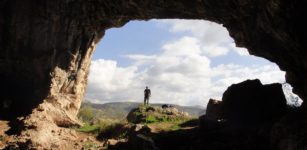 Startling Discovery Of Nubian Levallois Technology In Shukbah Cave Re-Writes Ancient History Of Neanderthals And Homo Sapiens
Archaeology | Feb 24, 2021
Startling Discovery Of Nubian Levallois Technology In Shukbah Cave Re-Writes Ancient History Of Neanderthals And Homo Sapiens
Archaeology | Feb 24, 2021

